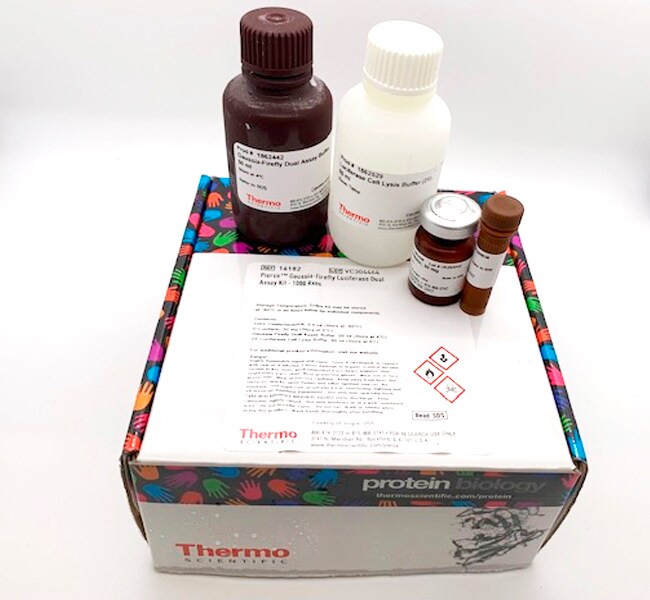
The Thermo Scientific Pierce Gaussia-Firefly Luciferase Dual Assay Kit provides the necessary reagents to simultaneously detect intracellular Gaussia and Red Firefly luciferase activity in mammalian whole cell lysates.
Features of the Gaussia-Firefly Luciferase Dual Assay Kit:
• Simultaneous—concurrent, filter-based, wavelength-separated detection of two luciferase activities
• Sensitive—measure bright blue Gaussia and red firefly luciferase activities in the same sample
• Fast—no quenching step required, unlike in traditional sequential dual assays
• Multiplex—capable of quantitating two cellular activities in the same sample(s)
The Pierce Gaussia-Firefly Luciferase Dual Assay Kit is a highly sensitive assay that allows for the simultaneous detection of Gaussia and Red Firefly luciferase activity. Gaussia luciferase acts as an experimental reporter with constitutively active red firefly as a normalization control. As shown in the animation videos below, this reporter-and-control combination enables simultaneous monitoring of experimental reporter and control luciferase activities in a single-read assay without the need for two-step addition of substrate reagents or quenching. The assay working solution contains substrates for both luciferases, and the reactions occur simultaneously with flash-type kinetics. The resulting luminescent signals are spectrally resolvable using filters. In a single sample, researchers can assay transcriptional activity of regulatory elements, signal transduction pathways, and effects of activators or inhibitors.
Includes:
Cell lysis buffer, reaction buffer, and substrates coelenterazine and D-luciferin
Requires:
Gaussia and Red Firefly luciferase reporters; Filter sets in the ranges of 425 to 525nm for Gaussia Luc and 615 to 675nm for Red Firefly Luc. Luminometer or other instrument capable of monitoring luminescence, such as Thermo Scientific Luminoskan Ascent and Varioskan Flash Microplate Readers; Injector required for assessing more than 24 wells at a time.
Applications:
• Study two regulatory elements at the same time
• Monitor two signaling pathways simultaneously
• Enable studying more than one target per screen (e.g. off-target effects)
Application Videos:
Gaussia luciferase produces brighter bioluminescent signal than firefly and native Renilla luciferases. The bioluminescent signal (λmax= 470nm) produced by Gaussia luciferase results from the oxidation of coelenterazine. This reaction does not require adenosine triphosphate (ATP) or other cofactors. Red firefly luciferase is a mutant form of the Japanese firefly luciferase from Luciola cruciata. This luciferase produces a red-shifted emission spectrum (λmax= 613nm) that results from the oxidation of D-luciferin in the presence of ATP. Red firefly and Gaussia luciferases are used in the dual assay because the light output is spectrally resolvable.
More Product Data
• Highly sensitive multiplex luciferase reporter assays
• Simultaneous dual-emission detection of luciferase reporter assays
• Activation of the antioxidant response pathway by pesticide chemicals
| Code | Description |
|---|---|
| 16182 | Catalog Number: 16182 |
| 16181 | Catalog Number: 16181 |

